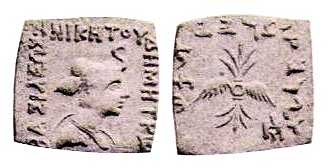.

Coin of Demetrius Aniketos.
Obv: Bust of king with kausia helmet. Greek legend BASILEOS ANIKITOU DIMITRIOU (Invincible king Demetrius).
Rev: Zeus with scepter and thunderbolt. Kharoshthi legend: MAHARAJASA APARAJITASA DIMETRIA (Invincible king Demetrius).
Demetrius III "The Invincible" is here identified with an Indo-Greek king who reigned in the area of Gandhara and Punjab for a short time around 100 BC.
Date of reign uncertain
The coins of Demetrius III are few and rather crude. He copies some of his imagery from the renowned Bactrian king Demetrius I (c.200-180 BC). The two namesakes share the war-like epithet Aniketos(Invincible) and wear elephant-crowns, the symbol that Alexander the Great used to celebrate his conquest of the Indus Valley.
The historical sources of the Indo-Greek kingdom are very few, and the separation of kings with the same name is not an easy process. Numismatician Bopearachchi identifies three kings named Demetrius, placing the third around 100 BC due to mintmarks and style of the coins. (See discussion under Demetrius II)
However, Demetrius III is the only Demetrius to strike bilingual Greek/Indian (Kharoshti) coins, and is therefore a likely candidate to be identified with the "Demetrius, king of the Indians" mentioned by Roman historian Justin. This Demetrius is said to have fought with the Bactrian king Eucratides (c. 170-145 BC) during the latter part of Eucratides' rule. Bopearachchi nevertheless identifies Justin's Demetrius with the king Demetrius II who only struck Greek coins and reigned c.175-170 BC.
To this author, the absence of absolute proofs of dating (such as counter-marked coins) means the problem is not definitely solved, and the alternative chronology would be to place Demetrius III around 150 BC.

Copper coins of Demetrius Aniketos.
Obv: Bust of king, wearing an elephant's scalp, with Greek legend: BASILEOS ANIKITOU DIMITRIOU (Invincible king Demetrius).
Rev: Winged thunderbolt. Kharoshthi legend: MAHARAJASA APARAJITASA DIMETRIA (Invincible king Demetrius).
Possible dynastic context
Given that the date 100 BC is correct, Demetrius III could be tentatively associated with other kings. Coins with elephant crowns were struck by one more king: Lysias (ca 110-120 BC) who ruled the western part of the Indo-Greek kingdoms. It is possible that Demetrius III was a relative of Lysias. Apart from the unusual elephant crowns, the two kings bear the same epithet ("Invincible") and show similar facial features. The deity of Demetrius III is however Zeus, unlike Lysias who associates himself with Heracles. But the king Antialcidas is known to be have been related to Lysias; he portrayed Zeus on his coins.
Thus Demetrius III might have belonged to the house of these western kings. A closer discussion is found under Heliokles II, who might have had a similar antecedentia. The fact that both these Demetrius III and Heliokles II bore the names of earlier kings support the hypothesis that they belonged to a dynasty.
Preceded by: Heliokles II
Indo-Greek Ruler (Gandhara and Punjab) (c.100 BC)
Succeeded by: Philoxenus
| Ancient Greece
Science, Technology , Medicine , Warfare, , Biographies , Life , Cities/Places/Maps , Arts , Literature , Philosophy ,Olympics, Mythology , History , Images Medieval Greece / Byzantine Empire Science, Technology, Arts, , Warfare , Literature, Biographies, Icons, History Modern Greece Cities, Islands, Regions, Fauna/Flora ,Biographies , History , Warfare, Science/Technology, Literature, Music , Arts , Film/Actors , Sport , Fashion --- |
Retrieved from "http://en.wikipedia.org"
All text is available under the terms of the GNU Free Documentation License

